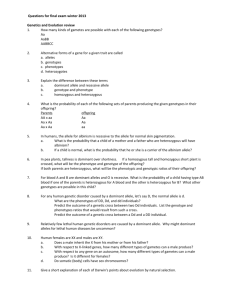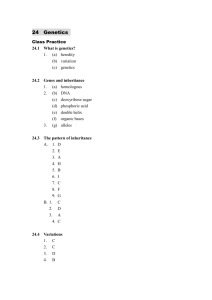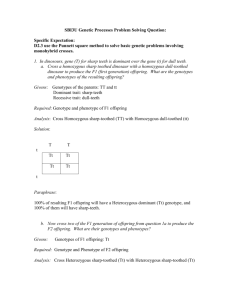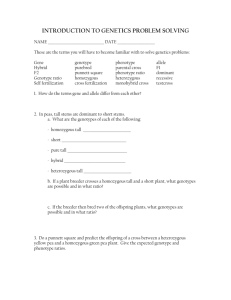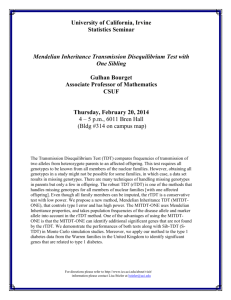Genetic Problems AP
advertisement
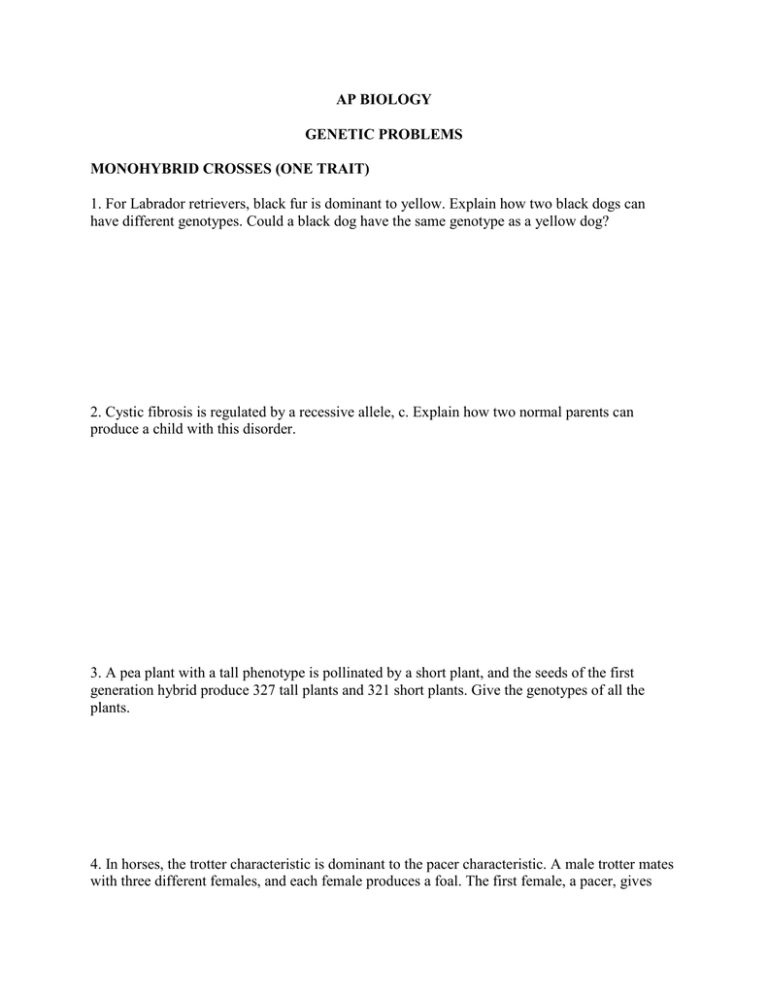
AP BIOLOGY GENETIC PROBLEMS MONOHYBRID CROSSES (ONE TRAIT) 1. For Labrador retrievers, black fur is dominant to yellow. Explain how two black dogs can have different genotypes. Could a black dog have the same genotype as a yellow dog? 2. Cystic fibrosis is regulated by a recessive allele, c. Explain how two normal parents can produce a child with this disorder. 3. A pea plant with a tall phenotype is pollinated by a short plant, and the seeds of the first generation hybrid produce 327 tall plants and 321 short plants. Give the genotypes of all the plants. 4. In horses, the trotter characteristic is dominant to the pacer characteristic. A male trotter mates with three different females, and each female produces a foal. The first female, a pacer, gives birth to a foal that is a pacer. The second female, also a pacer, gives birth to a foal that is a trotter. The third female, a trotter, gives birth to a foal that is a pacer. Determine the genotypes of the male, all three females, and the three foals sired. 5. Imagine for hair color that B gives brown hair and b gives blonde hair. Use a Punnett square to determine the following in a cross of two heterozygous parents. a) What are the chances of the offspring being homozygous brown haired? b) What are the chances of the offspring having blonde hair? c) What are the chances of the offspring being heterozygous brown haired? d) What is the genotypic ratio? e) What is the phenotypic ratio? f) Is there a heterozygous blonde haired offspring? Why? g) If curly hair is dominant to straight hair, what letters will we use to show these genes? h) A heterozygous curly haired male marries a straight haired female. What are their genotypes? i) What would be the gametes for the male parent? j) What would be the gametes for the female parent? k) What are the chances of the offspring being homozygous curly haired? l) What are the chances of the offspring having straight hair? m) What are the chances of the offspring being heterozygous curly haired? n) What is the genotypic ratio? o) What is the phenotypic ratio? p) Is there a heterozygous straight haired offspring? Why? DIHYBRID CROSSES (TWO TRAITS) 6.Black coat color (B) in cocker spaniels is dominant to white coat color (b). Solid coat pattern (S) is dominant to spotted pattern (s). The pattern arrangement is located on a different chromosome than the one for color, and its gene segregates independently of the color gene. A male that is black with a solid pattern mates with three females. The mating with female A, which is white, solid, produces four pups: two black, solid, and two white, solid. The mating with female B, which is black, solid, produces a single pup, which is white, spotted. The mating with female C, which is white, spotted, produces four pups: one white, solid; one white spotted; one black, solid; one black, spotted. Indicate the genotypes of the parents. INCOMPLETE DOMINANCE/BLENDING/CO-DOMINANCE (ONE TRAIT) 7. Sickle cell anemia displays incomplete dominance inheritance. In the heterozygous condition, red blood cells are mildly misshapen but in the homozygous condition, they are seriously deformed and result in considerable pain and tissue and organ damage. If two heterozygous individuals planned to have children, what information would you have for them concerning the possibilities of them having normal children. 8.The flower color alleles in the red and white 4 o'clock flower are incompletely dominant. If we mate a homozygous red flower (FRFR) with a homozygous white flower (FWFW), all of the F1 flowers are pink. If two pink flowered plants are crossed, a) What are the chances of having pink offspring? b) What are the chances of having red offspring? c) What are the chances of having white offspring? d) What is the genotypic ratio in the F2? e) What is the phenotypic ratio in the F2? MULTIPLE ALLELES (1 TRAIT) 9. In a disputed paternity case, Shaniqua has blood type B and has a child with type O. She claimed that it had been fathered by Raul, who has type A. What can be proved from these facts? 10. Indicate the blood types possible from the mating of a male who is blood type O with a female of blood type AB. Could a female with blood type AB ever produce a child with blood type AB? Could she ever have a child with blood type O? 11. Multiple alleles control the coat color of rabbits. A gray color is produced by the dominant allele C. The Cch allele produces a silver-gray color when present in the homozygous condition, CchCch, called chinchilla. When Cch is present with a recessive gene, a light silver-gray color is produced. The allele Ch is recessive to both the full color allele and the chinchilla allele. The Ch allele produces a white color with black extremities. This coloration pattern is called Himalayan. An allele Ca is recessive to all the other alleles. The Ca allele results in a lack of pigment, called albino. The dominance hierarchy is C > Cch > Ch > Ca. The table below provides the possible genotypes and phenotypes for coat color in rabbits. Notice that four genotypes are possible for full color but only one for albino. Phenotypes Genotypes Full color CC, CCch, CCh, CCa Chinchilla CchCch Light gray CchCh, CchCa Himalaya ChCh, ChCa Albino CaCa a) Indicate the genotypes and phenotypes of the F1 generation from the mating of a heterozygous Himalayan coat rabbit with an albino coat rabbit. b) The mating of a full color rabbit with a light gray rabbit produces two full color offspring, one light gray offspring, and one albino offspring. Indicate the genotypes of the parents. c) A chinchilla color rabbit is mated with a light gray rabbit. The breeder knows that the light grey rabbit had an albino mother. Indicate the genotypes and phenotypes of the F1 generation from this mating. d) A test cross is performed with light gray rabbit, and the following offspring are noted: five Himalayan color rabbits and five light gray rabbits. Indicate the genotype of the light-gray rabbit. SEX-LINKAGE 12. a.Hemophilia is a sex-linked trait carried on the X chromosomes that causes the inability to make a clotting factor. If the male has normal blood clotting factors and the female also has normal blood clotting, explain how their child can be afflicted with the recessive condition, hemophilia? b.What would be the chance of their daughter having hemophilia? 13. Calico is a codomininat combination of alleles carried on the X chromosome. The homozygous conditions are orange coat and black coat color. a. State a key for calico cats. b. What would the results of a cross of a calico and black cat? c. Is it possible to have a cross of 2 calico cats? Explain. CROSSING OVER 14. In two sweet pea strains, B = blue flowers, b = red flowers. L = long pollen grains, l = round pollen grains. In a cross between a heterozygous plant and a plant that has red flowers and round pollen, 44% of the offspring are blue, long; 44% are red, round; 6% blue, round; 6% are red, long. How many map units separate these two alleles? EPISTASIS (2 GENES COMBINING TO GIVE ONE PHENOTYPIC APPEARANCE) 15. Palomino horses are known to be caused by the interaction of two different genes. The allele Cr in the homozygous condition produces a chestnut, or reddish color, horse. The allele Cm produces a very pale cream color, called cremello, in the homozygous condition. The palomino color is caused by the interaction of both the chestnut and cremello alleles. Indicate the expected ratios in the F1 generation from mating a palomino with a cremello. PEDIGREE 16. For the family outlined below, draw a pedigree a) Generation I : A male with blood type O marries a female with blood type A. b) Generation II : They have 4 children. The first born is a male with A type blood, the second born is a girl with O type blood, and the last two children were identical twin boys. c) Generation III : The last boy married a woman with type B blood. They had two girls, one with AB blood type and one with B blood type.



